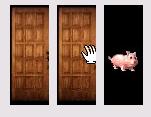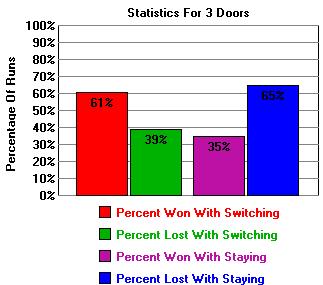What is Advanced Monty Hall?
This activity allows the user to experiment with conditional probability by choosing to stay or to switch doors. This applet also allows the user to control the number of doors to increase or decrease the probability of finding the right door.
Conditional probability is the probability that an event will occur based on the outcome of the previous event. The condition in this game is that following the user's initial door selection, one of the other doors is opened and the user is shown that the prize is not behind that door. Based on the information the user just learned, he has a better chance of guessing the correct door.
Probability began in the middle of the seventeenth century by a man named Pascal. One day a man proposed a question about gambling. His question was "If I play a game in which I have eight rolls to roll a six and I fail the first three times, how much of my bet should I get back?" The game involved chance just as most games do now, such as Monopoly and card games. Las Vegas is a city that is dominated by people that have invested in this field of mathematics. Today, probability has found its way into the fields of science, medicine, and statistics.
How Do I Use This Activity?
This activity allows the user to simulate the Monty Hall Game by selecting any number of doors between 3 and 10. The player can choose a door to open; this will reveal what is behind several of the doors, leaving some doors still closed. The player must then decide to stick with the original choice or change doors to reveal the prize.
Controls and Output
There are three sections to this activity: A Single Run panel, a Multiple Run panel, and a Cumulative Statistics panel.
The Single Run panel allows you to play a single game of Monty Hall.
-
You can change the number of doors by adjusting the scrollbar:

-
Below the scrollbar are the actual doors. To play, click on one of the doors. A hand will appear on the door you selected, and at least one door will open to reveal the "runner-up" prize:

You then either click on the door you originally selected, indicating that you want to stay with your original choice, or click on the remaining, unopened door. If you're lucky, the door will open to reveal the huge cash prize:

-
After you have played a round, you can reset the doors by clicking on the
Reset Doors button:

-
Finally, you can choose whether or not the results of your individual runs should be added
to the cumulative statistics panel, discussed below:

The Multiple Run panel allows you to simulate playing Monty Hall with doors ranging from 3 to 10 with up to 10,000 runs. If you would like to experiment with a larger number of doors, please use the Generalized Monty Hall activity.
-
You can change the number of doors and the number of trials by entering the correct values
into the text fields:

-
You can also specify your choice policy - whether you switch to the other unopened door
after the remaining doors were opened, or if you stay with your original choice:

-
When you have chosen the parameters for your experiment, you can click the
Run Experiment button. The results of your experiment will also be displayed below the button:

The Cumulative Statistics panel is used to show the overall results of your experiments with Monty Hall through both a table and a bar chart.
-
The table in the cumulative statistics panel shows the overall results of your
experiments:

-
Below the table is a row of charts that shows the relation between wins and losses for the
switching and staying policies:

-
You can also click on the individual charts to pull up a larger, more complete bar chart:

Description
This activity allows the user to simulate the Monty Hall Game with up to 10 doors in which the user chooses a door, and then all but one door is opened to reveal a stinking pig. The player must then decide to stick with the original choice or change. This activity would work well in groups of two to three for about thirty minutes if you use the exploration questions and ten to fifteen minutes otherwise.
Place in Mathematics Curriculum
This activity can be used to:
- introduce the notions of chance and probability
- motivate the notion of conditional probability
- motivate the notion of random numbers
Standards Addressed
Grade 6
-
Statistics and Probability
- The student demonstrates a conceptual understanding of probability and counting techniques.
Grade 7
-
Statistics and Probability
- The student demonstrates a conceptual understanding of probability and counting techniques.
Grade 8
-
Statistics and Probability
- The student demonstrates a conceptual understanding of probability and counting techniques.
Grade 9
-
Statistics and Probability
- The student demonstrates a conceptual understanding of probability and counting techniques.
Grade 10
-
Statistics and Probability
- The student demonstrates a conceptual understanding of probability and counting techniques.
Sixth Grade
-
Statistics and Probability
- Develop understanding of statistical variability.
Seventh Grade
-
Statistics and Probability
- Investigate chance processes and develop, use, and evaluate probability models.
Statistics and Probability
-
Conditional Probability and the Rules of Probability
- Understand independence and conditional probability and use them to interpret data
- Use the rules of probability to compute probabilities of compound events in a uniform probability model
-
Making Inferences and Justifying Conclusions
- Understand and evaluate random processes underlying statistical experiments
- Make inferences and justify conclusions from sample surveys, experiments, and observational studies
-
Using Probability to Make Decisions
- Calculate expected values and use them to solve problems
- Use probability to evaluate outcomes of decisions
Grades 9-12
-
Data Analysis and Probability
- Develop and evaluate inferences and predictions that are based on data
- Formulate questions that can be addressed with data and collect, organize, and display relevant data to answer them
- Understand and apply basic concepts of probability
Advanced Functions and Modeling
-
Data Analysis and Probability
- Competency Goal 1: The learner will analyze data and apply probability concepts to solve problems.
AP Statistics
-
Data Analysis and Probability
- Competency Goal 3: The learner will collect and analyze data to solve problems.
-
Number and Operations
- Competency Goal 1: The learner will analyze univariate data to solve problems.
7th Grade
-
Data Analysis and Probability
- The student will demonstrate through the mathematical processes an understanding of the relationships between two populations or samples.
8th Grade
-
Data Analysis and Probability
- The student will demonstrate through the mathematical processes an understanding of the relationships between two variables within one population or sample.
8th Grade
-
Probability and Statistics
- 8.11 The student will analyze problem situations, including games of chance, board games, or grading scales, and make predictions, using knowledge of probability.
- 8.11 The student will analyze problem situations, including games of chance, board games, or
Be Prepared to
- answer the question "What is Monty Hall?"
- discuss probability and conditional probability